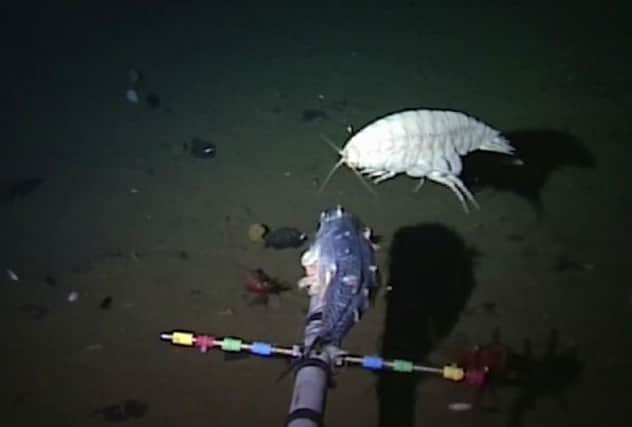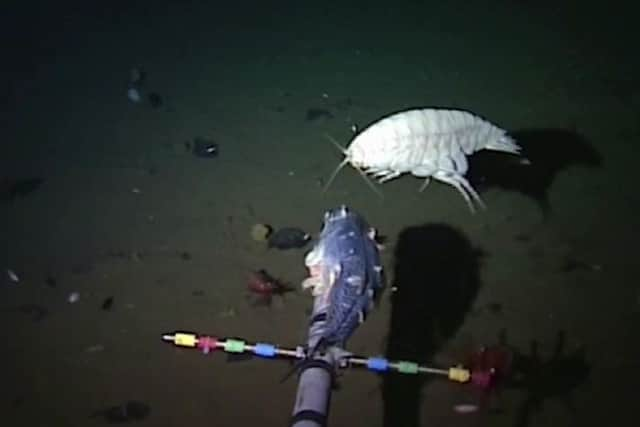Aberdeen University sets record for deepest fish


Using the UK’s deepest diving vehicle - the Aberdeenshire-built Hadal-Lander - the team, including researchers from Aberdeen, filmed the world’s deepest fish in the Mariana Trench, the deepest place on the planet as well as discovering a number of new species.
The team also recorded the first footage of the ‘supergiant amphipod’, a large crustacean recovered from traps off New Zealand in 2012.
Advertisement
Hide AdAdvertisement
Hide AdThe footage shows the ‘supergiants’ swimming, feeding and fending off predators.


Dr Alan Jamieson, of the Unviersity of Aberdeen, said: “Knowing these creatures exist is one thing, but to watch them alive in their natural habitat and interacting with other species is truly amazing, we have learnt a great deal.”
The team, made up of marine biologists, geologists, microbiologists and geneticists from around the world, have just returned from the first detailed examination of the Mariana Trench, using the Schmidt Ocean Institute research vessel Falkor.
The video footage, captured by the Oceanlab scientists, depicts a snailfish at depths of 8145 metres - the greatest depth at which a fish has ever been observed.
The researchers broke their own record set in 2008 by nearly 200 metres, and had already discovered a new species of snailfish living between 6000 and 8000 metres in the trench.
The discovery of a second, more elusive and fragile species surprised them, however.
CONNECT WITH THE SCOTSMAN
• Subscribe to our daily newsletter (requires registration) and get the latest news, sport and business headlines delivered to your inbox every morning
Dr Jamieson added: “This really deep fish did not look like anything we had seen before, nor does it look like anything we know of.
Advertisement
Hide AdAdvertisement
Hide Ad“It is unbelievably fragile, with large wing-like fins and a head resembling a cartoon dog.”
The aim of the University of Hawaii-led expedition was to characterise the environments, animals, ecological and geological processes of the deepest area of the world’s ocean.
Dr Jeff Drazen, co-chief scientist, explained: “Many studies have rushed to the bottom of the trench but from an ecological view that is very limiting. It’s like trying to understand a mountain ecosystem by only looking at its summit”.
The trip was the University of Aberdeen’s 14th expedition to the deep trenches, where they collected 105 hours of video - the greatest volume of footage ever taken at such depths.
Aside from the supergiants and deepest fish records, the team also filmed many other species of fish, setting new depth records for three other fish families.
The Hadal-Lander vehicle also successfully reached the bottom of the Sirena deep at 10,545 metres.
Dr Jamieson added: “We are particularly proud of this vehicle given it was designed and almost entirely built in villages in Aberdeenshire in the Northeast of Scotland.”
Wendy Schmidt, co-founder of the Schmidt Ocean Institute, said she was delighted with the success of the expedition, adding: “Rarely, do we get a full perspective of the ocean’s unique deep environments.
Advertisement
Hide AdAdvertisement
Hide Ad“The questions that the scientists will be able to answer following this cruise will pave the way for a better understanding of the deep sea, which is not exempt from human impact.”
Mariana Trench
The Mariana Trench is home to a number of nightmarish creatures, such as the Dragonfish, Viperfish, Fangtooth, Goblin Shark and Dumbo octopus.
Located east of the Philippines, the trench is so deep that even if Mount Everest was to be placed at the very bottom, the peak of the mountain would be submerged 2,076 metres below the surface of the ocean.
Its maximum known depth is 6831 miles at the Challenger Deep, a small valley in the floor of the trench.
SCOTSMAN TABLET AND IPHONE APPS